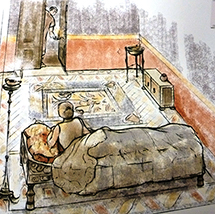The Roman villa of Arellano
Bedroom. Cubiculum
The Arellano mosaics adorned some of the rooms built after the renovation of the villa at the beginning of the 4th century AD, and the influence of oriental aesthetics is reflected in them, both in the design and treatment of the figures and in the choice of plant and geometric themes. They follow a specific iconographic programme: the myth of Cybele and Attis.
The master bedroom (cubiculum) was decorated with a precious mosaic pavement that has come down to us very deteriorated, due to agricultural works and erosion. The bed occupied the space with geometric decoration, leaving in view an emblem with figurative decoration in which the birth of Attis is represented, showing in the foreground a naked child sheltered in a cave and, in a second term, a female figure appears with a protective gesture that with her left hand hunts a swan. The scene takes place in an aquatic environment, alluding to the river Sangarius, where, according to some versions of the legend, Cybele picked up Attis as a child.
As for the myth of Cybele and Attis among classical authors, there are different versions of this legend, the most widespread is the one that tells how Cybele had fallen in love with Attis, an adolescent of great beauty. The goddess showered him with gifts and made him promise that he would always remain at her service and that he would never love another woman. But one day Attis met the nymph Sangaritis and betrayed Cybele. When the goddess found out what had happened, she killed the nymph and lost the spirit of Attis, who, in a fit of madness, committed suicide by cutting off his genitals.
How to get there: The easiest way to get there is from the Pamplona - Logroño motorway, a few kilometres past Estella in the direction of Logroño, take exit 51 to Arróniz, on the NA-6340. After a few kilometres, the museum complex appears on the right.
Important: All information.
scheduleSee web page.
Bibliography: María Ángeles Mezquíriz Irujo, La villa romana de Arellano, Gobierno de Navarra, Pamplona, 2003.













